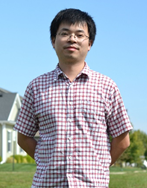
搜索网站、位置和人员

新闻与活动 活动信息
工学院学术研讨会Engineering Colloquium: Implantable Optoelectronic Devices for Advanced Neural Interfaces
时间
2021年7月30日(周五)
下午4:00-5:30
地点
西湖大学云栖校区2号楼611室
主持
西湖大学工学院PI 李兰
受众
全体师生
分类
学术与研究
工学院学术研讨会Engineering Colloquium: Implantable Optoelectronic Devices for Advanced Neural Interfaces
时间:2021年7月30日(周五)下午4:00-5:30
Time:30 July, Friday 2021, 4:00-5:30 PM
地点:西湖大学云栖校区2号楼611室
Venue: Room 611, 6F, Building 2, Yunqi Campus
主持人:西湖大学工学院PI 李兰
Host: Dr. Lan Li, PI of School of Engineering, Westlake University
主讲嘉宾/Speaker:

Prof. Xing Sheng 盛兴教授
清华大学电子工程系
Department of Electronic Engineering, Tsinghua University
盛兴,目前就职于清华大学电子工程系,担任副教授。2007年获得清华大学学士学位,2012年毕业于美国麻省理工学院,获得博士学位。2012年至2015年在伊利诺伊大学香槟分校从事博士后研究。主要研究兴趣是开发新型的光电子材料与器件,用于生物医疗技术特别是神经界面,曾以第一作者和通讯作者身份在Nature Materials, PNAS, Nature Communications, Advanced Materials等杂志发表论文20余篇。
Xing Sheng is currently working as an associate professor in the Department of Electronic Engineering at Tsinghua University, China. He received his bachelor and PhD degrees from Tsinghua University and Massachusetts Institute of Technology, respectively. He worked as a postdoctoral researcher at University of Illinois Urbana-Champaign. His current interests are primarily in the exploration of implantable micro- and nano-scale optoelectronic devices, to enable high performance and versatile applications in biomedicine. He has published more than 50 papers in peer-reviewed journals. He is currently serving as an associate editor for OSA Optical Materials Express. He is the recipient of Young Scientist Awards in Progress in Electromagnetics Research Symposium (PIERS) and Microsystems & Nanoengineering Summit (MINE) in 2018.
讲座摘要/Abstract:
微电子和光电子等信息器件与生物系统,特别是神经系统的集成逐渐成为一个重要的发展方向。我们通过探索新型的微纳器件工艺,结合光学、电学、力学的设计,开发微纳尺度的光电子材料与器件,并与柔性异质衬底进行集成,探索其在可穿戴、植入式等生物医疗领域的应用。本报告中,我计划探讨运用新型的光电材料与器件的设计方法和工艺策略,实现新型植入式光电芯片,用于生物神经信号的监测和控制,以及生物体内的无线能量传输。在未来,我们计划继续探索新型器件工艺,结合电路设计、能量传输、信号处理等多领域知识,开发新型多功能的神经科学传感、诊断、治疗系统。
Recent progresses in the design of mechanics and materials have given birth to flexible and stretchable electronics and photonics, enabling the integration of rigid inorganic devices with soft, elastic and curved biological systems. While current flexible photonic devices are mostly based on organic materials, bio-integrated high performance inorganic optoelectronic devices will provide new insights on interactions between light and bio-systems. Here we present unconventional strategies to design and fabricate thin-film, microscale optoelectronic devices and use them in implantable systems for biomedical applications. These devices are implanted deeply into the mouse brain, demonstrating close loop monitoring and manipulation of neural activity in vivo. Such an integrated, deeply implanted and microscale optoelectronic system provides new insights on interactions between optical signals and neural systems.
讲座联系人/Contact:
工学院办公室
戴老师 daixueping@westlake.edu.cn

















